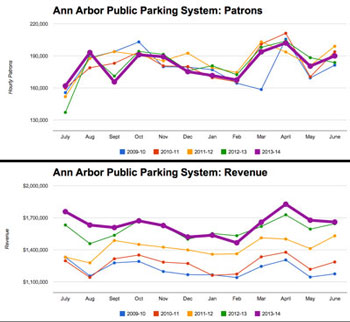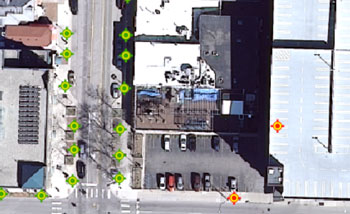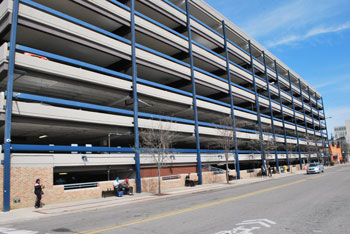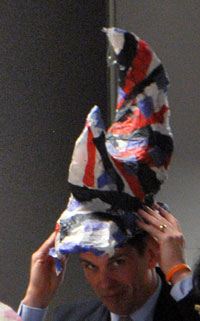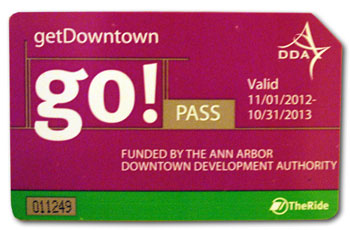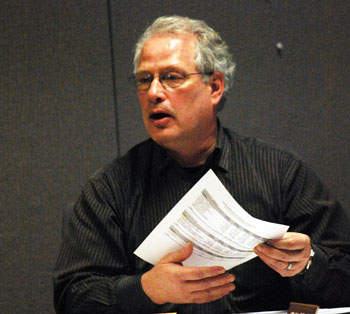Ann Arbor city council meeting (March 3, 2014): The most recent wrangling over public art, which began on Jan. 21, has finally been wrapped up – at least for now – by council action on three separate items. But the council postponed final action on three issues fraught with their own controversies: a resolution on an urban park for the top of the Library Lane underground parking structure; a funding proposal for the work of a pedestrian safety task force; and an ordinance regulating smoking in some outdoor spaces.

Jane Lumm (Ward 2) talked with Christopher Taylor (Ward 3) and Stephen Kunselman (ward 3) before the March 3 meeting started. (Photos by the writer.)
The delays allowed the council to wrap up a potentially long meeting relatively early, by around 10:30 p.m. As a part of the meeting, the council also approved a raft of routine items essential to keeping the city operational – like the purchase of 18 replacement vehicles.
In its three actions on public art policy, the council: (1) directed the city administrator to establish a budget for public art administration for the next two years; (2) transferred $943,005 out of the public art fund; and (3) extended the contract for the city’s part-time public art administrator by six months.
The transfer of Percent for Art money back to its funds of origin was made possible by an amendment to the city’s public art ordinance given final approval by the council on Feb. 18. The $943,005 total is an amount that defunds the art project at Argo Cascades, but keeps funding for the Coleman Jewett memorial and for a project called Canoe Imagine Art. The art projects at East Stadium bridges and at the Kingsley & First rain garden would also retain their funding. Because the resolution involves a transfer of funds, it required eight votes on the 11-member council to be approved. The vote on the question was 10-1 with Margie Teall (Ward 4) dissenting.
An additional resolution approved by the council focused exclusively on the transition to a new public art program. The resolution directed the city administrator to ask the staff to develop a transition plan, and to present that plan to the council by Oct. 6, 2014. The resolution also prohibits initiating additional projects using pooled Percent for Art funds, and directs the city administrator to establish a budget for public art administration for FY 2015 and FY 2016. Because it did not transfer any funds, the resolution on establishing a timeline and a budget did not require more than a simple six-vote majority. Dissenting on the vote were: Mike Anglin (Ward 5), Sumi Kailasapathy (Ward 1), Jane Lumm (Ward 2) and Jack Eaton (Ward 4).
The third public art resolution approved by the council on March 3 was one that extended the contract for the city’s part-time public art administrator by six months, appropriating $18,500 for that purpose – drawn from Percent for Art money. The item first appeared on the council’s Jan. 21 agenda.
A resolution that would have established an urban park on a portion of the surface of the Library Lane underground parking structure was delayed, amid the expressed intent by Stephen Kunselman (Ward 3) to bring forward a companion resolution to hire a broker to sell the rights to build on top of the parking structure. The urban park resolution, which was put forward by Jack Eaton (Ward 4), had resulted from his work with the Library Green Conservancy. It drew on recommendations on downtown parks made last year by the park advisory commission (PAC).
But the resolution drew criticism from both the current and former chair of PAC during public commentary at the meeting, as they said it flouted two of PAC’s eight recommendations: that additional parks not be established as a trade-off to maintenance of existing parks; and that open space on top of the Library Lane parking structure be designed in the context of adjacent development.
The consideration of the urban parks resolution spurred mayor John Hieftje to counter with an item he placed on the agenda the day of the March 3 council meeting: a slideshow he presented early in the meeting to argue for consideration of several open spaces downtown, including the surface lot on the northeast corner of Main & William. The council will take up the urban park resolution again on March 17.
In other parks-related business on March 3, the council also approved funding for the reconstruction of basketball and tennis courts at Clinton Park in the southern part of town. And the council approved applying for a grant from the Michigan Dept. of Natural Resources Grants Management to help pay for a universal access playground at Gallup Park. The Rotary Club of Ann Arbor has already pledged $250,000 toward that playground.
Delayed at the council’s March 3 meeting was a resolution that would have established funding for a pedestrian safety and access task force. Councilmembers had concerns about the amount of funding, which totaled $197,250. That amount includes approximate costs of the anticipated city staff effort for the project. Councilmembers also had concerns about the use of funds to hire an outside consultant as a facilitator. The council will take up the pedestrian task force funding issue again on April 7, by which time the task force is expected to have held its initial meeting.
Related to pedestrian issues at the March 3 meeting, the council approved funding for the design of two sidewalks – on Barton Drive and Scio Church Road – as well as funds to construct a section of sidewalk on Ann Arbor-Saline Road.
Also on March 3, police chief John Seto briefed the council on increased traffic enforcement activities conducted with a $125,000 allocation the council had made at its Dec. 16, 2013 meeting – in the same time frame as the pedestrian task force was created. Seto also briefed the council on year-end crime statistics for 2013.
Another item delayed until April 7 was an ordinance that would regulate smoking in certain outdoor locations, outside of building entrances and possibly in some areas of some public parks. Councilmembers had various concerns, ranging from the possible disparate impact on the homeless to the difficulty of enforcement. Chuck Warpehoski (Ward 5) expressed some frustration that he was just now hearing about these various concerns from his colleagues, even though he had brought the ordinance forward on Feb. 3 and asked for their comments and questions at that time.
The council did take action to direct the city administrator to develop a budget amendment that would allocate $600,000 from the city’s affordable housing trust fund to help the Ann Arbor Housing Commission pay for capital improvements. Approval of that amendment by the city council would be contingent on the upcoming closing of the sale of city-owned property at Fifth & William streets in downtown Ann Arbor – the former Y lot. Net proceeds of the sale, at around $1.4 million, are to be deposited in the affordable housing trust fund.
In routine business, the council approved the purchase of 18 replacement vehicles, most of which are used by the Ann Arbor police department. And finally, the council passed a resolution calling on state officials to find creative ways to provide full funding to a state program designed to give fire protection grants to municipalities that are home to state-owned institutions, like the University of Michigan. [Full Story]




